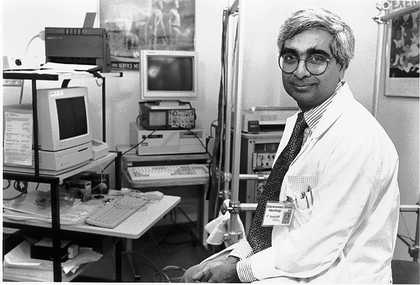
Dr. Subrumanian Sriram is developing strategies to attack the disease of multiple sclerosis at its core.
Investigators battling MS by attacking disease's roots
Researchers in the VUMC Multiple Sclerosis Center are working on a way to halt demyelination – the stripping of the protective coating on nerve fibers that is at the core of the disease Multiple Sclerosis (MS).
Myelin, a whitish fatty sheath, shields the nerve fibers and electrically insulates them from one another. This insulation increases the speed of transmission of nerve impulses. Myelinated nerve fibers conduct impulses more than 150 times faster than unmyelinated fibers.
Once the myelin has been stripped, scar tissue develops that hinders the passage of nerve impulses to the organs and muscles, eventually causing weakness, clumsiness, blindness, and urinary incontinence.
This demyelination of nerve fibers is at the root of the development of MS, a disease of unknown cause which strikes millions of Americans each year.
Dr. Subrumaniam Sriram, William C. Weaver professor of Multiple Sclerosis Research, is developing a strategy to attack these myelin stripping microglial cells. Instead of searching for what causes the microglial cells to activate, Sriram is simply looking for a way to turn them off.
"We know the activation of microglial cells is responsible for making the final 'hit' and stripping the myelin from the underlying nerve fiber. We think that if we can understand what activates these microglial cells we may set up a strategy to deactivate them," said Sriram.
Microglial cells are scavenger cells that accumulate at the site of infection and carry away bacteria or other foreign bodies that would otherwise be harmful.
One of the molecules that Sriram thinks is critical in the activation of these microglial cells is called Interleukin 12 (IL12). In activated microglial cells, Sriram found excess amounts of the molecule IL12.
"One of our strategies is to see if we can down-regulate these macrophages to make less IL12," said Sriram.
Down-regulation slows the cells' production of chemicals. Slowing IL12 could help curb the process of demyelination in Multiple Sclerosis, Sriram said.
"When a cell is activated, it is making a lot of chemicals that are toxic in the wrong place at the wrong time. They can be good if you want to get rid of an infection, but if they get activated for other reasons they can be harmful to the tissue in which they are present," he said.
Sriram has been working on an animal model that mimics human MS. The demyelinating disease in animals is experimental allergic encephalitis.
The preliminary data suggest that deactivating the microglial cells halts the progression of the disease. Hopefully, the same strategy of deactivating the microglial cells can be used in humans. More study, however, is needed in order to ensure that the human and animal models will work in the same way.
"We have received a grant from the National Institutes of Health, a biotech transfer grant, to study this model. We have teamed up with a biotech company in Seattle in order to explore these issues," said Sriram.
Sriram also holds a grant from the National Multiple Sclerosis Society, which supports his effort to bring the IL12 strategy to clinical trials in humans.













